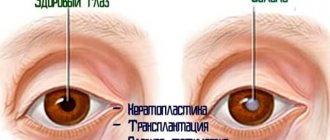Good afternoon, my dear readers!
Today the weather outside is not the best: thunderous rain, piercing wind. Maybe this is why I am in a sad mood. And I chose a serious topic for today’s article, which we have never mentioned before. I found this information on one of the sites dedicated to vision problems, and it made me think.
Myopia, farsightedness, astigmatism - all these phenomena, of course, are unpleasant and sometimes interfere with life. But much more terrible is blindness, which is irreversible. And therefore it is very important to pay attention to the slightest signs of an impending threat and take action in advance.
In our wise body, everything is interconnected, and often disturbances in one organ can warn us of more serious diseases. One of these signs is visual field impairment. We’ll talk about what it is today.
[direct]
Concept of field of view
The field of view is the space visible to the eye. It is determined with a stationary position of the head and a maximally fixed gaze directed forward.
If you take this position, then central vision will allow you to clearly see the objects at which your gaze is directed. Objects on the sides, visible in peripheral vision, will be less clear.
Loss of visual fields in humans
A healthy person can see the fingers of a hand that is moved to the side by at least 85 degrees. If this angle is smaller, then there is a narrowing of the field of view.
And if a person sees with each eye only part of the space enclosed in an imaginary right angle, then there is a loss of halves of the visual field. This is a serious symptom of a serious disease of the brain or nervous system.
Accurate diagnosis of visual field loss occurs when the patient is examined by a doctor. Modern medicine has well-developed techniques for examining such patients.
Local loss of half or quarters of the visual fields is called hemianopia . It can be bilateral, that is, the fields of both eyes fall out.
There is also a concentric type of prolapse, reaching tube vision, when the gaze fixes almost one point.
This symptom may accompany optic nerve atrophy, the last stages of glaucoma. But it can also be a temporary phenomenon associated with psychopathic conditions.
A focal loss of visual fields is called a scotoma . It is accompanied by the formation of islands, which are perceived as shadows or spots. It happens that the patient does not notice the scotoma, and it is discovered only during examination.
The loss of an area in the very center of the visual field indicates macular degeneration, an age-related degenerative lesion of the macula (macula) of the retina.
Medicine is making significant strides in the treatment of many of the diseases mentioned. Therefore, patients must follow all measures prescribed by the doctor. This is the key to the success of treatment.
Source https://ya-viju.ru/vypadenie-polej-zreniya
Reasons for violations
The nature of visual field loss depends on the cause that causes it. The most common cause is diseases of the light-receiving apparatus of the eye.
If the loss of the visual field looks like a curtain on any side, the cause is either retinal detachment or a disease of the visual system pathways. With retinal detachment, in addition to loss of the visual field, distortion of the shape and broken lines may be observed. In addition, the amount of visual field loss may be different in the morning and evening.
Sometimes patients note that they see the image as if through water (it “floats”).
The causes of retinal detachment can be high myopia, retinal dystrophy, or previous eye trauma.
If the outer halves of the visual field (from the temple) fall out, especially in two eyes, an enlargement of the pituitary gland (adenoma) can be suspected.
Loss of the visual field in the form of a dense or translucent curtain from the nose may be one of the signs of glaucoma, and “fog” or colored rainbow circles may be periodically observed when looking at a light bulb.
Loss of the visual field in the form of a translucent curtain on any side can be caused by opacities of the optical media of the eye, such as: cataract, pterygium, cataract, opacification of the vitreous body.
If some area in the center of the visual field falls out, the cause is a malnutrition of the central zone of the retina (macular degeneration) or the optic nerve (partial atrophy).
Macular degeneration, in addition, is often accompanied by distortion of the shape of objects, curvature of lines, and changes in the size of individual parts of the image.
Concentric narrowing of the visual field (tube vision) is most often a consequence of a special form of retinal dystrophy - its pigmentary degeneration, while high central visual acuity remains for quite a long time.
Advanced glaucoma can also cause a concentric narrowing of the visual field, but with it the acuity of central vision suffers much earlier.
In everyday life, a concentric narrowing of the visual field manifests itself as follows: a person approaches the door, takes out the key and looks for the keyhole for a long time. Such people become almost helpless in an unfamiliar environment; they need a lot of time to familiarize themselves with it.
With sclerosis of the cerebral vessels with impaired nutrition of the visual center of the cerebral cortex, a concentric narrowing of the visual field can also be observed, but it is more often accompanied by a significant decrease in the acuity of central vision, forgetfulness, and dizziness.
Source https://www.glazmed.ru/lib/public09/what008.shtml
How to treat wet macular degeneration of the retina?
Wet retinal macular degeneration is a form of AMD. It appears in humans when pathological blood vessels begin to grow behind the retina under the macula. Doctors call this type of eye disease exudative (or neovascular). Overgrown vessels have fragile walls, and blood and other fluid often leak from them. Under their influence, the macula rises from its place, and this leads to pathological changes in this area of the retina.
A working method to restore vision! You will throw your glasses in the trash in just 3 days...
Restoring vision. Real life story.
Wet macular degeneration progresses quite quickly, much faster than dry macular degeneration. This predetermines a sharp deterioration in a person’s vision. Such retinal dystrophy leads to the patient losing central vision.
This degeneration of the visual organs does not have stages of development (unlike dry) and is known as late age-related macular degeneration. Although this form of the disease affects only 10% of all people with this disease, it leads to a complete loss of vision in 90% of people. This is not blindness, but a significant loss of vision functions.
Wet retinal macular degeneration: types of disease
This disease is mainly divided into two categories: latent disease and classic form. The first type of retinal dystrophy appears at the moment when the blood vessels under the retina grow so that they are almost invisible. With this type of disease, a less severe form of vision loss occurs for the patient.
Classic retinal dystrophy occurs when the growing vessels are clearly visible, and their scarring has certain contours. This age-related macular degeneration occurs in a very severe form. It can lead to almost complete loss of vision in a person.
These two types of dystrophy are based on the process of so-called choroidal neovascularization (CNV). This is an unproductive desire of the body to create an additional network of blood vessels to improve the flow of blood with nutrients and oxygen to various parts of the eye. But instead of positive results, this process leads to scarring, then to the patient losing central vision. Retinal dystrophy occurs. An absolute scotoma appears in the center of the eye - a dark spot. Peripheral vision is completely preserved, since macular degeneration of the retina affects only its central area. The patient's visual acuity drops sharply, as he sees only with peripheral vision. At the same time, he does not distinguish small details, the shape of objects and their color.
Retinal dystrophy: causes and symptoms
The disease can develop under the influence of various factors, the main of which are:
- Increasing human age.
- Bad heredity.
- Poor nutrition, lack of essential microelements and vitamins in food.
- Smoking and alcoholism.
- Damage to the eye from ultraviolet radiation.
Signs of the disease may not appear immediately. The initial symptoms that indicate that a person is developing retinal dystrophy are the occurrence of difficulties in reading or those types of work where small details are present.
Then symptoms appear: blurred vision, difficulty recognizing faces. Retinal dystrophy progresses: the patient sees curved projections instead of straight lines. The symptoms of the disease begin to intensify: if a person develops wet retinal dystrophy, then at the next stage of the disease’s progression the patient sharply loses central vision.
This process can lead to two results:
- A slight decrease in the acuity of perception of objects.
- Complete loss of vision in the central part of the retina.
If the second option has developed, then the patient’s quality of life changes dramatically, but he is not in danger of complete blindness, since peripheral vision is practically not affected.
Methods for diagnosing the disease
In order for the treatment of the disease to be successful, it is necessary to accurately determine the stage of development of the disease. To do this, at the first stage, the patient’s complaints are recorded and his external examination is carried out. This often helps determine whether a person has a disease. Then the dystrophy is studied by an ophthalmologist using an ophthalmoscope. The patient is sent for examination of the vessels in the retinal area (fluorescein angiography). Doctors use photographic equipment to remove the bottom of the patient's retina.
His visual acuity is checked. Using perimetry and electrophysiological examination, doctors determine the degree of development of the disease and the preservation of the macula’s functions. A person is asked to undergo an Amsler test, which allows one to find distortions in the functioning of the patient’s eye. Treatment is then prescribed, the duration of which often depends on the extent of damage to the patient's retina.
Treatment of retinal diseases and preventive measures
It is very difficult to treat a person with such a disease. In order to properly organize treatment, doctors need to choose one of two existing methods of providing assistance to the sick person. For this, a conservative method and treatment with laser coagulation can be used.
The use of medications that are injected into the eyeball is the most effective treatment. For these purposes, drugs such as Lucentis and Avastin are used. This method prevents new blood vessels from developing under the retina and saves vision.
Sometimes treatment of this disease is carried out through laser coagulation. It helps stop bleeding from newly formed vessels. But the use of this method has some limitations, since the procedure is accompanied by the release of heat, which can damage the delicate tissues of the eye. Therefore, such treatment is used not to combat the disease itself, but to stop the process of its development. Since an effective way to combat the disease has not yet been invented, implementation of preventive measures plays an important role.
If a person discovers symptoms of the above-mentioned disease, he should contact the appropriate ophthalmological clinics, where there is specialized diagnostic and laser equipment, and ophthalmologists. There the patient will be examined, a diagnosis will be made, and if necessary, a medication will be injected into the eyes.
Scientists from different countries have practically proven that there is a direct relationship between what a person eats and the appearance of dystrophic changes in the retina of his eyes.
People who eat plenty of fruits, leafy greens and tuberous vegetables are less likely to get sick. This happens because the above products contain a large amount of microelements, vitamins, antioxidants, and nutrients that the body needs. The main ones are theaxatin and lutein, which have an important effect on the development of the retina. Their presence in the right quantity allows for disease prevention.
You can use modern vitamin complexes that contain these substances, for example, Anthocyan-Forte or Lutein-Complex.
They can be purchased at the pharmacy.
How is the verification done?
Visual field defects must be examined in a patient who comes with complaints of decreased vision. Having examined the nature of the disorder, the specialist must establish the location of the lesion, its localization and, based on this, formulate a diagnosis or prescribe any additional diagnostic tests. They will provide the most accurate diagnosis.
There are many well-known methods for assessing visual fields.
You can do a little experiment. You need to look into the distance, stretching your arms out to the sides at shoulder level and moving your fingers. If peripheral vision is normal, then a healthy person will notice the movement of his fingers.
If a person loses peripheral or central vision, then he can be considered blind.
Many people believe that only central vision is important, but this is not at all true. Without peripheral vision, it is absolutely impossible to drive a car, even with the minimum level of safety.
Peripheral and central vision can be affected by various diseases, one of which is glaucoma. With this disease, the field of vision slowly narrows.
Visual field impairment is a serious symptom and you should immediately consult a specialist doctor for advice.
The study of visual fields, first of all, determines where the damage is located - in front of, in the area or after the visual intersection.
If the scotoma is detected in only one eye, the damage is localized to the optic chiasm, affecting the retina or optic nerve.
Visual disorders of the eye can be either independent or in combination with other disorders of the central nervous system, speech disorders, disorders of consciousness, etc. They can occur when blood circulation in the brain's visual centers is impaired. This usually affects middle-aged and young people.
The first signs of vegetative-vascular disorders are loss of visual fields. After a few minutes, they slowly move across the field of vision to the left and right and are very well felt when the eyelids are closed.
During this period, visual acuity decreases significantly. After about half an hour, a severe headache appears.
The first thing you can do to help the patient is to lay him on the bed and remove the clothes that restrict his movement. It will be useful to give him a Validol tablet under the tongue and a cup of strong coffee. In case of relapses, it is best to consult an ophthalmologist or neurologist.
The vision test will be carried out using special computerized instruments. Small points of light flash against a dark background. The computer will register the location and size of the area that was not visible.
Source https://healthyeyes.ru/narushenie-zreniya.html
Changes in field of view
Pathological changes in the visual field can be caused by a variety of reasons. Despite the variety of such changes, all of them can be conditionally divided into two large groups:
- focal visual field defects (scotomas);
- narrowing the boundaries of the field of view.
Changes in visual fields in various pathologies of the central nervous system are very characteristic and are the most important symptoms for the topical diagnosis of brain diseases.
Focal defects (scotomas)
The absence of visual function in a limited area, the contours of which do not coincide with the peripheral boundaries of the visual field, is called scotoma .
Such visual impairment may not be felt at all by the patient himself and may be detected during special research methods (so-called negative scotoma ).
In some cases, the scotoma is felt by the patient as a local shadow or spot in the field of vision ( positive scotoma ).
Scotomas can have almost any shape: oval, circle, arc, sector, irregular shape. Depending on the location of the area of vision limitation in relation to the point of fixation, scotomas can be central, paracentral, pericentral, peripheral or sectoral.
If visual function is completely absent in the area of the scotoma, such a scotoma is called absolute.
If the patient notes only a focal disturbance in the clarity of perception of an object, then such a scotoma is defined as relative .
It should be noted that in the same patient, scotoma can be detected in different colors, both absolute and relative.
In addition to all kinds of pathological scotomas, humans have physiological scotomas.
An example of a physiological scotoma is the well-known blind spot - an oval-shaped absolute scotoma, determined in the temporal region of the visual field, and representing a projection of the optic nerve head (this area does not have light-sensitive elements).
Physiological scotomas have clearly defined sizes and localization, while an increase in the size of physiological scotomas indicates pathology. Thus, an increase in the size of the blind spot can be caused by diseases such as glaucoma, hypertension, and papilledema.
To identify scotomas, previously specialists had to use rather labor-intensive methods of examining the visual field. Nowadays, this process has been greatly simplified by the use of automatic perimeters and central vision testers, and the examination itself takes only a few minutes.
[direct2]
Changing the boundaries of the field of view
Narrowing of the visual field can be global in nature (concentric narrowing) or local (narrowing of the visual field in a certain area with unchanged boundaries of the visual field throughout the rest of the area).
Concentric narrowing
The degree of concentric narrowing of the visual field can be either slight or pronounced, with the formation of the so-called tube visual field.
Concentric narrowing of the visual field can be caused by various pathologies of the nervous system (neuroses, hysteria or neurasthenia), in which case the narrowing of the visual field will be functional.
In practice, concentric narrowing of the visual field is most often caused by organic lesions of the visual organs, such as peripheral chorioretinitis, optic neuritis or atrophy, glaucoma, retinitis pigmentosa, etc.
To establish what kind of narrowing of the patient’s field of vision the patient has, organic or functional, a study is carried out with objects of different sizes, placing them at different distances. In case of functional impairment of the visual field, the size of the object and the distance to it have virtually no effect on the final result of the study. For differential diagnosis, the patient’s ability to orientate in space is also important: difficult orientation in the environment is usually caused by organic narrowing of the visual field.
Local narrowing of the visual field can be unilateral or bilateral. Bilateral narrowing of the visual field, in turn, can be symmetrical or asymmetrical.
In practice, the complete bilateral absence of half the visual field - hemiopia, or hemianopia - is of great diagnostic importance. Such disturbances indicate damage to the visual pathway in the area of the optic chiasm (or behind it).
Hemianopsia can be detected by the patient himself, but much more often such disorders are detected during visual field examination.
Hemianopsia can be homonymous, when the temporal half of the visual field is lost on one side, and the nasal half of the visual field on the other, and heteronymous - when the nasal or parietal halves of the visual field are symmetrically lost on both sides.
In addition, a distinction is made between complete hemianopsia (the entire half of the visual field falls out) and partial, or quadrant, hemianopsia (the border of the visual defect starts from the point of fixation).
Hemianopsia
Homonymous hemianopsia occurs when there are volumetric (hematoma, neoplasm) or inflammatory processes in the central nervous system, causing retrochiasmal damage to the visual pathway on the side opposite to the loss of the visual field. Patients may also have symmetrical hemianoptic scotomas.
Heteronymous hemianopsia can be bitemporal (the outer halves of the visual field are lost) or binasal (the inner halves of the visual field are lost).
Bitemporal hemianopsia indicates damage to the visual pathway in the area of the optic chiasm; it often occurs with pituitary tumors.
Binasal hemianopsia occurs when the pathology affects the uncrossed fibers of the optic pathway in the area of the optic chiasm. Such damage can be caused, for example, by an aneurysm of the internal carotid artery.
Treatment and prevention
Special exercises to improve vision significantly expand the field of lateral vision.
At the first problems with visual perception, it is advisable to determine the cause of their occurrence. Only an experienced specialist can help with this, who will prescribe appropriate treatment to eliminate visual disturbances.
To improve lateral vision, it is recommended to perform appropriate eye exercises. In addition to expanding peripheral space, special classes will help increase brain functionality and also develop lateral visibility.
Exercises to expand peripheral vision
- Focus your gaze on a specific point that is at least 3 meters away. Without taking your eyes off, you should spread your hands holding pencils to the sides, gradually increasing the area in which the outlines of white objects do not disappear from the field of vision.
- Continuously look at the object, assessing the current situation around with peripheral vision. To achieve positive results, a detailed analysis of surrounding objects should be carried out.
- An equally effective exercise can be performed while traveling on a train or bus. It is necessary to concentrate your gaze on one object. Using the peripheral areas of the eye, it will capture another object. And gradually increase their number.
Lateral vision is an integral and essential component of a person’s full life. The slightest disturbance in visual perception leads to a deterioration in the quality of life, a change in worldview, and the appearance of complexes and fears. Therefore, taking good care of your health, including timely and preventative visits to an ophthalmologist, is the key to excellent health of both central and lateral vision.











